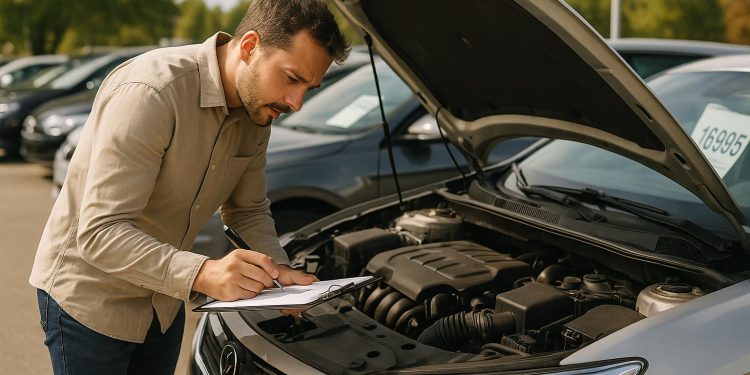Buying a used car can save you money, but it comes with risks. Hidden issues like engine problems, poor maintenance, or mismatched VINs can lead to costly repairs. This guide highlights 10 key warning signs to watch for, from accident damage to paperwork errors, so you can avoid expensive mistakes.
Key Takeaways:
- Accident History: Check for hidden damage with a VIN report.
- Service Records: Missing or sketchy history can signal neglect.
- Engine Issues: Listen for strange noises, inspect for leaks, and check exhaust smoke.
- Dashboard Lights: Persistent warning lights need professional diagnostics.
- Wear and Tear: Excessive wear can indicate higher usage than reported.
- Transmission Problems: Rough shifts or noises are red flags.
- Brake Issues: Soft pedals, noise, or vibrations require attention.
- Steering/Suspension: Loose steering or clunking sounds may signal costly repairs.
- Tires: Uneven wear could mean alignment or suspension problems.
- Paperwork/VIN: Ensure all documents match the vehicle’s VIN to avoid legal trouble.
Pro Tip: Always get a professional inspection, especially for "as-is" sales, where repair costs fall entirely on you. Certified used cars with warranties, like those from AUTO24.co.za, can provide added peace of mind.
Never Buy a Used Car Without Checking These 18 Red Flags
1. Accident Damage
When you’re shopping for a used car, accident damage should always raise a red flag. Damage from past accidents can sometimes be hidden, but it might compromise the car’s safety and leave you dealing with expensive repairs down the road.
To avoid surprises, get a professional to run a thorough diagnostic and a VIN check. These steps can help reveal any history of accidents or concealed damage.
If you’re buying the car "as-is", missed accident damage could lead to unexpected repair bills and persistent mechanical problems. It’s better to catch these issues upfront than deal with them later.
2. Missing or Questionable Service Records
A well-documented service history is a good indicator of proper care and maintenance, while missing or suspicious records can hint at potential costly repairs down the road.
Complete service records should cover everything from regular oil changes to scheduled maintenance and major repairs. If there are gaps in the timeline, records that only show basic upkeep, or no documentation for critical work like timing belt replacements or brake repairs, it’s worth raising an eyebrow. These omissions could mean important maintenance was skipped, leaving you with unexpected – and often expensive – problems.
Be cautious of questionable records, too. Handwritten receipts, unusually low service costs, or inconsistencies with the vehicle’s mileage might signal a falsified maintenance history.
To ensure the service records are legitimate, take a systematic approach. Start by verifying the records through a trusted platform that offers detailed vehicle history reports. These platforms often consolidate official service entries, making it easier to spot discrepancies.
You can also dig deeper with a few additional steps. Request a diagnostic test to uncover any hidden mechanical issues that might point to neglect. Use the vehicle’s VIN to access a comprehensive history report, which can help you cross-check the records provided by the seller.
If no records are available, don’t skip a professional inspection. Have a qualified mechanic examine the car for signs of proper maintenance – or neglect.
Once you’ve reviewed the service history, turn your attention to the engine to check for any concealed problems.
3. Engine Problems
The engine is the heart of any vehicle, and when it starts acting up, repair costs can escalate fast. That’s why a thorough inspection is absolutely necessary.
Start by turning the car on and paying close attention to the sounds it makes. A healthy engine should purr quietly. If you hear knocking, rattling, or any other strange noises, it’s a red flag that something might be wrong.
Pop the hood and look for any signs of trouble, like fluid leaks or anything that seems out of place. Don’t forget to check the oil – both its level and condition. A dipstick covered in dirty or low oil can hint at deeper engine problems.
Pay attention to the exhaust as well. If you notice smoke or unusual discoloration coming from the tailpipe, it’s often a sign of a bigger issue lurking beneath the surface.
When taking the car for a test drive, keep an eye on the temperature gauge. A properly functioning engine should warm up and stay within the normal range. If it doesn’t, or if the car struggles to accelerate smoothly, that’s another warning sign.
Finally, check the dashboard for any illuminated warning lights. These lights often confirm what you’ve observed and shouldn’t be ignored. If anything seems off, it’s best to take the car to a trusted mechanic for a professional opinion.
4. Dashboard Warning Lights On
Before starting the engine, take a moment to inspect the dashboard. Any illuminated warning lights could signal potential problems that need attention.
The check engine light is often the most alarming. This amber light could mean anything from a loose gas cap to severe engine trouble. Don’t brush off claims that it’s just a minor sensor issue – investigate further.
ABS and brake warning lights point to possible problems with the braking system, which is a critical safety concern. Likewise, airbag warning lights suggest there may be issues with the vehicle’s safety systems.
Oil pressure and temperature warning lights can indicate engine trouble if ignored, while battery and charging system lights hint at potential electrical issues. These warnings reinforce the importance of earlier checks for engine sounds and leaks, emphasizing the need for thorough diagnostics.
Be aware that some sellers might reset warning lights by disconnecting the battery or using diagnostic tools to mask problems. While this might temporarily turn off the lights, the underlying issues can resurface after a few driving cycles. This is why a professional diagnostic check is essential.
To protect yourself, always request a thorough diagnostic scan for any used car you’re seriously considering. These scans can uncover stored fault codes, even if the warning lights have been reset by the seller. Be particularly cautious with "as-is" vehicles, as any repair costs will be your responsibility.
If warning lights are present during your inspection, don’t ignore them. A professional diagnostic can pinpoint the issue and provide an estimate for repairs. This information can give you an edge during negotiations or help you decide if it’s better to walk away.
5. Heavy Wear and Tear
Once you’ve tackled mechanical issues and warning lights, it’s time to evaluate the car’s wear and tear – this can often reveal more about its history than the odometer does. The condition of the vehicle should align with its reported mileage. If you spot wear that seems excessive for the stated mileage, it could signal hidden issues or even potential tampering.
Start by focusing on the interior, particularly areas that see the most use. Check the driver’s seat, pedals, and steering wheel. Is the seat padding worn down? Does the steering wheel feel unusually smooth or shiny, as if it’s been handled far more than expected? These can be subtle indicators that the car has been used more heavily than advertised.
Next, take a close look at frequently touched parts like door handles, window controls, and the gear shifter. Uneven wear – where one part looks significantly older than another – should raise questions. It might suggest inconsistent maintenance or even parts replacements.
Don’t stop at the interior. The exterior can tell a story, too. Inspect the paint and trim for fading, sun damage, or areas that have clearly been touched up. These could hint at long-term exposure to harsh conditions or neglect. Tires are another crucial checkpoint – do they look worn down or mismatched compared to the car’s overall condition? This could be another red flag.
Finally, dig into the less obvious spots inside the car. Look at the floor mats and carpeting for stains, heavy wear, or signs they’ve been replaced. Sometimes, new mats are thrown in to mask the car’s real age or usage. Even small details like these can provide important clues.
If the wear and tear don’t match the car’s reported mileage, take it as a serious warning. You may need to investigate further, negotiate a lower price, or, if things seem off, walk away entirely.
6. Transmission or Gearbox Issues
The transmission is a critical component – and an expensive one to repair – so catching problems early is key.
When taking the car for a test drive, pay close attention to how the transmission behaves. For automatics, the shifts should feel smooth and quick. If you notice any rough jolts, hesitation, or delays when changing gears, it’s a red flag. For manual transmissions, gear changes should be seamless, without grinding noises or resistance.
Keep your ears open, too. Strange sounds, like persistent clunking or whining, or an engine that revs without the car picking up speed, could point to serious internal transmission trouble.
It’s always a good idea to have a professional mechanic inspect the transmission and run a diagnostic scan before you commit to buying. This kind of detailed check goes hand-in-hand with the broader mechanical inspections mentioned earlier.
Transmission problems don’t usually fix themselves. If you spot any warning signs, consider negotiating a lower price or walking away from the deal altogether.
sbb-itb-09752ea
7. Brake Problems
Brakes aren’t just another car component – they’re your first line of defense on the road. If there’s any hint of trouble, it’s crucial to act fast. Let’s break down the key warning signs to ensure your brakes are in top shape.
Start by checking the brake pedal. When you press it, the pedal should feel firm and responsive – not soft or spongy. If it slowly sinks to the floor under steady pressure, this could point to a brake fluid leak or worn-out components that need immediate attention.
Take the car for a test drive and focus on how it stops. Braking should feel smooth and controlled, with the car coming to a stop in a straight line. If the vehicle pulls to one side, it may indicate uneven brake pad wear, warped rotors, or contaminated brake fluid, all of which can compromise your safety.
Pay attention to sounds while braking. Grinding, squealing, or scraping noises are red flags that likely mean the brake pads are worn down, possibly causing damage to the rotors.
Notice any vibrations in the brake pedal or steering wheel? A pulsing sensation often signals warped rotors, which can reduce braking efficiency and make stopping less predictable.
Don’t forget about the parking brake. It should engage smoothly and hold the car steady on a slight incline. If it feels loose, requires too much effort, or doesn’t hold the vehicle securely, it’s time for a closer look.
Lastly, inspect the brake fluid reservoir under the hood. The fluid should be clear or light in color. Dark brown or black fluid is a sign of contamination, which can damage internal brake components and reduce stopping power.
Brake issues are non-negotiable. If you notice any of these problems, address them immediately – whether that means negotiating repairs or walking away altogether. Safe, reliable braking is a cornerstone of vehicle safety, complementing the engine and suspension checks you’ve already completed.
8. Steering and Suspension Problems
The steering and suspension systems are essential not just for a smooth driving experience but also for your safety. When these systems aren’t working properly, they can lead to serious hazards and expensive repairs if ignored.
Start by testing the steering wheel. It should respond immediately without any excessive play. If it feels loose or unresponsive, it could point to worn tie rods or a failing steering box.
Next, evaluate how the car tracks on the road. A properly aligned vehicle should drive straight when you hold the steering wheel lightly. If the car pulls to one side or requires constant correction to stay in your lane, it might signal alignment issues, uneven tire wear, or suspension problems.
Pay attention to any unusual noises, especially when turning or driving over bumps. Clunking or creaking sounds are often signs of worn suspension components like struts, shocks, or ball joints. These noises tend to become more noticeable during sharp turns or on uneven terrain.
You can also check the suspension by pressing down on the hood or trunk and observing how quickly the car settles. On the road, the suspension should absorb bumps smoothly. If the ride feels harsh or the car seems to float, it’s a sign that the suspension components may need replacing.
Steering wheel vibrations are another red flag. While minor vibrations can stem from tire issues, persistent shaking often points to problems with wheel bearings, suspension parts, or steering components.
A visual inspection is just as important. Look under the car for fluid leaks around the shock absorbers or struts. Wet or oily spots usually indicate a failed internal seal.
Addressing steering and suspension issues early can save you from repairs that might cost thousands of dollars. A properly functioning system not only ensures a more comfortable ride but also enhances the safety of your vehicle, complementing the other mechanical checks you’ve performed.
9. Uneven Tire Wear or Bad Tire Condition
Tires can tell you a lot about a car’s overall health. Uneven tread wear often points to alignment or suspension problems, which, if left unchecked, could lead to expensive repairs. Take a close look at all four tires to ensure the wear is even across each one. This step also ties back to earlier checks on the vehicle’s alignment and suspension systems.
If you notice one side or a specific area of a tire wearing down faster than the rest, it’s a red flag that the alignment or suspension might need immediate attention.
Also, keep an eye out for cracks, bulges, or punctures. These issues not only compromise the tire’s strength but also pose serious safety risks.
10. Paperwork and VIN Problems
Paperwork mistakes can throw a wrench into buying a used car. One key step is ensuring the Vehicle Identification Number (VIN) matches perfectly across all documents – title, registration, insurance, and even the license plate.
Think of the VIN as the car’s unique fingerprint. Any mismatch could hint at past issues, like title fraud or incorrect records. Double-check the VIN on the dashboard (visible through the windshield) and compare it to the one on the driver’s side door jamb. Both should align with the information on every document.
If you’re still unsure, consider hiring a professional VIN verification service. It’s a small investment that can save you from potential legal headaches or financial losses down the road.
Lastly, go over all the paperwork thoroughly. Don’t hesitate to ask questions if something doesn’t add up – a trustworthy seller will always provide clear and complete documentation.
How to Rank and Handle Warning Signs
When buying a used car, not all warning signs carry the same importance. Building on earlier checks for mechanical and safety issues, it’s essential to rank these red flags so you can focus on what matters most. Knowing how to prioritize can save you money and keep you safe.
Issues with brakes, steering, or suspension are deal-breakers. No matter how tempting the price, it’s smarter to walk away from a car with serious safety concerns. Below is a guide to help you decide which problems are worth negotiating over and which should prompt you to move on.
The type of sale plays a big role in how to handle warning signs. Certified used cars usually come with a thorough inspection and a 6-month warranty, which can cover some repairs. On the other hand, "as-is" sales leave all repair costs – and risks – on your shoulders.
Here’s a quick breakdown of how to assess warning signs based on the type of sale:
| Warning Sign Category | Certified Used Car | As-Is Sale |
|---|---|---|
| Safety Issues | Walk away | Walk away |
| Major Mechanical Problems | Might be covered under warranty | Full cost falls on you – often a deal-breaker |
| Cosmetic or Wear-and-Tear Items | Could be a point for negotiation | Negotiable, but weigh the repair costs carefully |
Before making a decision, get repair estimates to figure out whether minor issues are worth negotiating or if they’re hiding bigger problems. A diagnostic can clarify whether a warning light points to something simple or a costly repair.
If you’re looking at an "as-is" car without a roadworthy certificate, expect additional expenses to make it safe to drive. Repairs for brakes, tires, or emissions compliance can add up, so factor those into your total investment.
Also, don’t overlook unresolved paperwork or mismatched VIN numbers – these are automatic deal-breakers, as mentioned earlier.
Finally, keep in mind that multiple warning signs usually mean higher risks and costs. If you’re unsure, proceed cautiously and consult extra resources for safe car buying tips.
Extra Tips for a Safe Purchase
When you’re test-driving a car, make it count. Take the vehicle through different scenarios – city streets, highways, parking lots, and even hilly terrain. Pay close attention to how the engine performs during acceleration, whether the brakes respond smoothly, and if the steering feels balanced or pulls to one side. Keep your ears open for any unusual sounds like grinding, squealing, or knocking, as these could signal underlying problems.
Beyond the test drive, getting a professional inspection is a smart move that could save you from expensive repairs down the road. A mechanic’s trained eye might catch issues you overlooked. This step is especially important when buying an "as-is" vehicle, where the buyer assumes full responsibility for any hidden defects or future repairs. Spending a little on an inspection now can prevent major financial headaches later.
Finding the right mechanic for a pre-purchase inspection is key. Look for someone experienced with the specific make and model of the car you’re considering. Many trusted platforms offer specialized inspection services for used cars, ensuring you get a detailed evaluation before making a commitment.
Choosing a reputable dealer can also make a big difference in your buying experience. For instance, platforms like AUTO24.co.za prioritize transparency and reliability. Their certified used cars go through rigorous checks, covering over 100 inspection points. Plus, they offer a 6-month mechanical warranty on non-wear-and-tear parts and a 5-day refund policy for added peace of mind.
"Buy used cars with trust and transparency"
"All our cars have been checked thoroughly"
– AUTO24.co.za
Customer reviews back up their claims. Amanda Van Rooyen, a satisfied customer, shared her experience:
"Best service received and wat a great family is auto 24 could not ask for better thanks guys"
– Amanda Van Rooyen
Finally, double-checking the car’s history is a must, even after mechanical inspections. As previously mentioned, ensuring all documentation is in order is your last line of defense. Use diagnostic tools to uncover any hidden electronic or emissions-related issues that might not be visible during a routine check.
Taking these extra precautions helps ensure you’re making a well-informed, risk-free purchase.
Conclusion
Buying a used car doesn’t have to feel like rolling the dice – careful inspection can make all the difference. Each warning sign you spot hints at potential problems that could lead to costly repairs down the road. If you encounter multiple red flags, it’s often better to step back or get a professional diagnostic evaluation before making any commitments.
Keep in mind that with "as-is" sales, you’re fully responsible for any repairs, with no option for returns or refunds. Even when sellers disclose some issues upfront, hidden problems may still surface, leaving you with unexpected costs. This is why a thorough inspection is absolutely critical.
Pair your own inspection with a professional diagnostic whenever possible. If you come across multiple issues – especially if key documents like a roadworthy certificate are missing – the risks increase dramatically.
From strange engine noises to mismatched VINs, every detail matters. Platforms like AUTO24.co.za can help by offering certified vehicles that come with detailed inspections and warranties for added peace of mind. In the end, these warning signs are there to guide you. Whether it’s unusual dashboard lights, uneven tire wear, or missing paperwork, each clue deserves close attention. By following the inspection tips in this guide, you can steer clear of common pitfalls and make a choice you’ll feel confident about.
FAQs
How can I confirm that a used car’s service records are genuine?
To ensure a used car’s service records are legitimate, start by looking for official dealership stamps or signatures on the documents. Match these details with the car’s Vehicle Identification Number (VIN) to confirm the records correspond to the specific vehicle.
Another step is to reach out to the service centers mentioned in the records and verify the maintenance history directly with them. Additionally, obtaining a CARFAX report or a similar vehicle history report can provide extra assurance about the car’s background. Keep an eye out for any missing or inconsistent records, as these might signal maintenance gaps or potential problems.
What should I do if I notice several red flags during a used car inspection?
If you notice several warning signs during a used car inspection, it’s wise to pause and assess the situation thoroughly. Major concerns such as engine problems, extensive rust, or evidence of past accidents might lead to expensive repairs in the future.
In these cases, reaching out to a trusted mechanic for a professional evaluation can be a smart move. If the issues seem severe or the seller refuses to resolve them, it’s often best to move on and look for another vehicle. Prioritizing a car that feels dependable and meets your expectations is always the safer choice.
Why is it important to check that the VIN matches across all documents when buying a used car?
The Vehicle Identification Number (VIN) is a one-of-a-kind code assigned to every car, serving as its fingerprint. It’s essential that this number matches across all key documents – like the title, registration, and the car itself. If there’s a mismatch, it could point to serious issues such as fraud, a stolen vehicle, or errors in documentation.
Taking the time to verify the VIN ensures the car’s history checks out. This simple step can protect you from legal headaches, ownership disputes, or unknowingly purchasing a car with concealed problems.
Related Blog Posts
- Where to buy safe used cars in South Africa
- Avoid scams when buying used cars in SA
- What to Check Before Buying a Used Car in South Africa
- Hidden Costs When Buying a Used Car in South Africa





